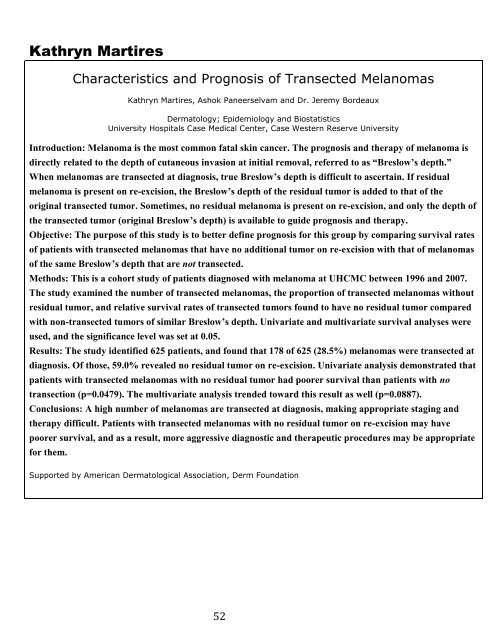student research day - Case Western Reserve University School of ...
student research day - Case Western Reserve University School of ...
student research day - Case Western Reserve University School of ...
You also want an ePaper? Increase the reach of your titles
YUMPU automatically turns print PDFs into web optimized ePapers that Google loves.
Kathryn Martires<br />
Characteristics and Prognosis <strong>of</strong> Transected Melanomas<br />
Kathryn Martires, Ashok Paneerselvam and Dr. Jeremy Bordeaux<br />
Dermatology; Epidemiology and Biostatistics<br />
<strong>University</strong> Hospitals <strong>Case</strong> Medical Center, <strong>Case</strong> <strong>Western</strong> <strong>Reserve</strong> <strong>University</strong><br />
Introduction: Melanoma is the most common fatal skin cancer. The prognosis and therapy <strong>of</strong> melanoma is<br />
directly related to the depth <strong>of</strong> cutaneous invasion at initial removal, referred to as “Breslow’s depth.”<br />
When melanomas are transected at diagnosis, true Breslow’s depth is difficult to ascertain. If residual<br />
melanoma is present on re-excision, the Breslow’s depth <strong>of</strong> the residual tumor is added to that <strong>of</strong> the<br />
original transected tumor. Sometimes, no residual melanoma is present on re-excision, and only the depth <strong>of</strong><br />
the transected tumor (original Breslow’s depth) is available to guide prognosis and therapy.<br />
Objective: The purpose <strong>of</strong> this study is to better define prognosis for this group by comparing survival rates<br />
<strong>of</strong> patients with transected melanomas that have no additional tumor on re-excision with that <strong>of</strong> melanomas<br />
<strong>of</strong> the same Breslow’s depth that are not transected.<br />
Methods: This is a cohort study <strong>of</strong> patients diagnosed with melanoma at UHCMC between 1996 and 2007.<br />
The study examined the number <strong>of</strong> transected melanomas, the proportion <strong>of</strong> transected melanomas without<br />
residual tumor, and relative survival rates <strong>of</strong> transected tumors found to have no residual tumor compared<br />
with non-transected tumors <strong>of</strong> similar Breslow’s depth. Univariate and multivariate survival analyses were<br />
used, and the significance level was set at 0.05.<br />
Results: The study identified 625 patients, and found that 178 <strong>of</strong> 625 (28.5%) melanomas were transected at<br />
diagnosis. Of those, 59.0% revealed no residual tumor on re-excision. Univariate analysis demonstrated that<br />
patients with transected melanomas with no residual tumor had poorer survival than patients with no<br />
transection (p=0.0479). The multivariate analysis trended toward this result as well (p=0.0887).<br />
Conclusions: A high number <strong>of</strong> melanomas are transected at diagnosis, making appropriate staging and<br />
therapy difficult. Patients with transected melanomas with no residual tumor on re-excision may have<br />
poorer survival, and as a result, more aggressive diagnostic and therapeutic procedures may be appropriate<br />
for them.<br />
Supported by American Dermatological Association, Derm Foundation<br />
52
















